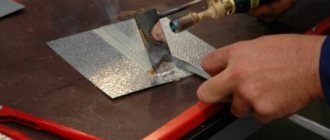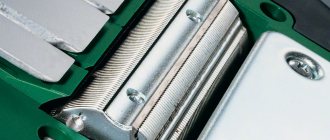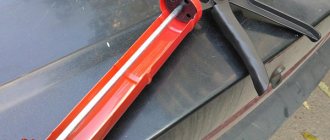Anyone who has done soldering knows that this procedure requires tin (solder) and flux. There are many varieties of the latter, which are selected depending on the process technology; solder fat is one of them. Some beginners and amateurs prefer to use rosin or soldering flux, because they consider this method more convenient. Others simply do not know about the existence of solder fat and its distinctive qualities.
To close this gap in knowledge, let's look at what this substance is, what properties it has, and also find out its scope.
What is solder fat
Don't let the word "fat" confuse anyone. Flux has nothing to do with organic matter. In fact, the pancreas is a chemical combination of various reagents. In its appearance and some properties the substance resembles lard. In practice, two types of flux are used: neutral and active flux.
Advantages
Specialists and radio amateurs choose soldering oil because of a number of its advantages:
- flux ensures uniform coverage of the soldering area with solder;
- Tinning metal surfaces helps achieve a mirror effect;
- the high viscosity of the substance allows you to maintain an accurate dosage within the intended limits;
- after soldering is completed, excess gel is easily washed off with water or a special solvent;
- market availability and low price are some of the attractive features of PG.
Flaws
- The pancreas has an unpleasant odor, which is especially active during soldering;
- Active flux is aggressive towards thin contacts of electronic parts;
- Fumes from molten flux are harmful to breathing. When working, you need to use personal protective equipment (gauze bandage, glasses).
Cooking recipes
Sometimes, when repairing electrical appliances at home, there is an urgent need to create a soldering mixture with your own hands. The manufacturing process itself does not require much effort or money, the main thing is to have the necessary material available and follow the sequence of actions.
To obtain neutral solder fat, it is necessary to place rosin in a container and bring it to the melting stage. Then, stirring, add stearin. As the mass cools, its viscosity can be determined. If the fat hardens quickly, the procedure is repeated, adding stearin until the desired consistency is obtained.
Preparing an active mixture at home is a difficult process, requiring the exact percentage of all components. For fat you need:
- water – 2%;
- technical petroleum jelly – 10%;
- zinc chloride – 10%;
- GOI pastes 54 – 78%.
Pour zinc chloride powder into a porcelain bowl, add water and slowly stir gently. Technical Vaseline is added to the resulting mass. Everything is mixed until a homogeneous liquid is formed.
GOI paste is added into the resulting emulsion in small portions. The finished mixture is thoroughly stirred to evenly distribute all components and placed in a jar.
An important condition when repairing equipment using soldering mixtures is a stable, high-quality connection of parts. Sometimes, most often among novice solders, defects occur when soldering contact units.
The reason for this may be a violation of the chemical composition of the flux, when the specific gravity exceeds the established norm, and during the action the substance does not float to the surface. Dissolving in details does not have the best effect on them.
To avoid such situations, before starting work it is necessary to check the solder fat for suitability. To do this, the mixture is applied to the base metal plate and heated over low heat.
The white coating that appears after the moisture evaporates should melt and spread smoothly. If the fat collects in balls, this indicates its unsuitability.
To check the neutrality of a mixture prepared at home, you need to apply one gram of the substance to paper.
Introduce a drop of an acid-base indicator into the resulting stain, which will quickly conduct a visual study. With the correct concentration of components, the substance does not change its color.
Anyone who has done soldering knows that this procedure requires tin (solder) and flux. There are many varieties of the latter, which are selected depending on the process technology; solder fat is one of them. Some beginners and amateurs prefer to use rosin or soldering flux, because they consider this method more convenient. Others simply do not know about the existence of solder fat and its distinctive qualities.
To close this gap in knowledge, let's look at what this substance is, what properties it has, and also find out its scope.
Composition of solder fat, physical and chemical properties
Neutral flux is an alloy of rosin and stearin. Active solder fat is a complex composition. This is paraffin, petroleum jelly, zinc chloride and ammonium mixed with dielectric water.
Soldering gun
The gel applied to the contacts of radio components becomes like a form that the molten solder takes. The properties of the PG provide an ideal flat surface of the applied metal. The solder spreads in an even layer without bumps or depressions.
The viscous structure of the flux allows you to initially outline the contours of future soldering. When the soldering iron tip is heated, the flux liquefies, which helps the solder softly and quickly take the desired shape.
Important! The properties of solder gel make it possible to create connections between metal parts of complex configurations.
Advantages
- The use of solder fat ensures smoother tinning and even spreading of solder;
- The material has better soldering properties than its closest competitors;
- The cost of flux is relatively low and it is available in almost all places;
- The viscosity of the material ensures easy dosage accuracy, as well as shape retention with precise placement on small parts;
- When used, virtually no traces are left;
- If after soldering fat remains on the surface, it can be easily removed with water.
Flaws
- Soldering with solder fat, especially if we are talking about the active variety, is harmful to health due to the chemical fumes that are in the composition;
- During operation, almost all parts become greasy and require mandatory cleaning, which can damage thin microcircuits;
- Contact with this flux itself is not very pleasant to work with due to the smell and consistency.
Composition and physicochemical properties of solder fat
The composition of solder fat depends on which type it belongs to. The simplest is neutral, since it only contains a rosin-stearic base. Active solder fat consists of the following components:
- Paraffin;
- Petrolatum;
- Deionized water;
- Zinc chloride;
- Ammonium chloride.
The properties of the flux ensure the softness of the process itself. Thanks to it, the solder itself takes on a fat-like shape and easily spreads over the surface. Unlike other fluxes, this one provides a smooth surface of the spread metal without deformed areas. This is noticeable even during tinning, since the solder film is applied to the base metal without bumps or sharp transitions in one easy movement.
Solder fat can be dissolved in organic solvents, which works well at high temperatures. During soldering, it itself easily changes its structure, becoming more pliable. The viscosity of the substance before the process itself ensures easy preparation and placement of the flux, and then the transition to a liquid state with increasing temperature helps better spreading
Features of choice
Before choosing, you should decide what solder fat is needed for, since the type depends on this. If you need to perform normal soldering procedures without having to deal with particularly difficult conditions and old parts, then ordinary neutral solder fat will do just fine. It is safer and easier to use and does not corrode metal.
- What it is
If you need to prepare metal products for soldering that have been in use for a long time and have been badly damaged by rust and other types of contamination, then it is advisable to use active fat. For standard procedures it should not be chosen, as it gives a high probability of corrosion at the joint. To prevent this, it is necessary to thoroughly clean the adhesion site after the procedure, since fat always leaves traces.
It is also worth considering the volumes and containers in which the delivery is carried out. If you decide to use this particular flux and the discomfort of use, as well as the slight risk of corrosion, does not bother you, then it is advisable to take a larger volume, since this is a really high-quality substance that will help improve the quality of soldering. If you are taking it for the first time, then you should choose the minimum volume that you can quickly use and understand how suitable it is for you personally.
Features of application and soldering
Many people who encounter such a substance for the first time are wondering how to solder with soldering fat. There are no particular difficulties here, since the soldering process itself is very similar to all others. First of all, you need to prepare the surface of the base metal so that it is as clean as possible.
The next step is tinning the surfaces to be soldered. To do this, dip the soldering iron tip into flux and take a small amount of solder.
Surface tinning process
The soldering surface must also be covered with grease. Then the molten solder covers the entire surface with a thin layer, which helps protect it from the re-formation of oxides and other deposits. A greasy film does not form from such a flux.
Solder fat melting
Then the parts are connected to each other and a thicker layer of solder is applied to them, which should cover the full area of the connection with a small margin. After this, you need to clean the surface with.
Overview of species
Soldering flux - what is it and what is it for?
There are two types of fat flux:
- Passive (neutral).
- Active.
Passive
Stearic-rosin flux is called neutral fat. It is used for soldering printed circuit boards of mobile phones and other complex electronic devices. Flux removes the oxide film of the metal, removes various foreign and oxide films during soldering of copper using lead-tin solder.
The product has found wide application not only in industry, but also in everyday life. The flux adheres well to any metal contacts. Due to its viscosity, accurate dosing of the material and high speed of solder application are achieved.
The gel is applied with a wooden stick, toothpick or match. At the end of soldering, the remaining flux is washed off with Galosh gasoline, isopropanol or a special remover.
Soldering fat neutral
Active
Active flux is used for soldering heavily corroded parts made of different metals. The product is used to restore corroded contacts of radio components of devices that have been damaged by moisture.
A board that has been in water for some time is tried to remove rust as much as possible with alcohol. Active soldering flux is applied to contacts damaged by rust. They are then soldered with solder. The remaining gel is washed off with warm water.
Active flux
Features of choice
To decide on the type of flux, you should know what it is for. If you plan to work with parts in normal condition, then it is enough to use a neutral product.
In cases where it is necessary to prepare the soldering of old radio components under difficult conditions, active fat is used.
Note! Upon completion of soldering work, the installation site must be thoroughly cleaned of active flux. The slightest residue can provoke the resumption of corrosion processes on the board.
Paste technology
If you have not used this composition yet, then our instructions for working with solder paste will help you:
- First you need to clean the board, degrease and dry thoroughly;
- install the board horizontally and fix it in this position;
- the paste is applied evenly at the specified connecting points without gaps;
- small and smd elements are placed on the board;
- in some cases, for greater reliability, it is necessary to treat the chip legs with paste;
- in the case of lower heating of the board, it is necessary to run a hair dryer and warm up the upper area with the fastening element with a warm stream;
- after the flux has evaporated, the temperature should be increased to the solder melting level;
- soldering must be constantly controlled;
- let cool and wash the board.
To manipulate microcircuits, you need to use a soldering iron at +250 - +300 Co. It is allowed to use models 20-30 W and 12-36 V.
You can solder SMD components like this:
- place them on the contact pad;
- apply the paste to the legs;
- under the influence of a soldering iron at a given temperature, the paste spreads over the contact area;
- leave the elements to cool.
Note!
To solder wires, solder paste is applied to the wires in the connection area. Then a soldering iron is applied to the paste.
Making solder fat with your own hands
Pulse soldering iron gun
On the Internet you can find a lot of recipes for making homemade solder fat. The product contains various chemical ingredients.
All recipes have one goal in common - to achieve maximum adhesion of the lead-tin alloy and displacement of oxides from the soldering process. Fat compounds are divided into passive and active compounds.
Making neutral fat
Neutral flux is a rosin-stearic mixture. Both reagents are commercially available. The manufacturing process consists of the following stages:
- Rosin is ground to a fine powder and placed in a glass jar.
- Stearin is also poured there. The mixture is made up in a 1:1 ratio.
- The jar with the contents is heated in the microwave.
- The oven is set to medium power mode and turned on for 4 minutes.
- The mixture turns into a homogeneous viscous mass.
Rosin for soldering
The resulting neutral solder grease may have insufficient viscosity. Some experts advise adding palm kernel oil (cooking fat). In this case, the proportion of the composition of the pancreas will be as follows:
- rosin - 3 hours;
- stearin – 2 hours;
- cooking oil – 1 tsp.
The addition of palm kernel oil gives the product a density that makes the gel convenient for loading it into a syringe.
Production of active solder fat
To make active flux you will need the following components:
- paraffin;
- zinc chloride;
- deionized water;
- petrolatum;
- ammonium chloride.
Paraffin
The substance is a by-product of oil refining. It is a white plastic fusible material. You can buy paraffin at household chemical stores.
Zinc chloride
The chemical is a white crystalline powder. Its melting point is 3200 C. Easily dissolves in water, alcohol, glycerin and acetone. The average price of zinc chloride is 220 rubles/kg.
Deionized water
Water is purified in a special installation from ions of impurities of various substances. It is most often purchased in pharmacies or online stores. The average price of 1 liter is 80 rubles.
Petrolatum
The purified petroleum product is sold in pharmacies and cosmetics stores. It is inexpensive - from 40 rubles. for the tuba.
Ammonium chloride
Ammonium chloride, or ammonia, is an odorless, white crystalline powder. Finding it on sale is not difficult. Half a kilo of the product can be bought for 150 rubles.
There are no exact instructions for preparing active solder fat. Usually all components are mixed in approximate proportions:
- Vaseline – 10%;
- zinc chloride – 10%;
- ammonia – 10%;
- paraffin – 28%;
- deionized water – 2%.
The resulting product is stored in a closed container (a glass jar with a lid), which is kept in a dark and cool place.
Homemade solder fat
Can it be done at home?
Can you create your own solder paste at home? Of course yes!
Ingredients: palm kernel oil, ammonium chloride (5-10%), aniline hydrochloride.
Method of preparation: mix ammonium chloride and aniline hydrochloride with palm kernel oil until a homogeneous paste is obtained.
Ingredients: vegetable oil (100 g), beef fat (300 g), natural rosin (500 g), ammonium chloride (100 g).
Method of preparation: melt the oil, fat and rosin in a wide porcelain cup in a water bath. Grind ammonium into powder and add to the mixture. Mix thoroughly to form a paste.
Ingredients: ammonium chloride (100 g), mineral oil (900 g).
Method of preparation: grind the ingredients in a porcelain mortar. Store in a closed glass container.
Finally we did it! I’ve been planning this for a long time, my subscribers have been asking for it for a long time. We still made this same solder paste. In fact, the task turned out to be not as difficult as I initially imagined it.
To make solder paste with your own hands, we will need:
1. A rod of tin-lead solder (solder paste base);
2. Medical vaziline (thickener);
3. A little flux LTI-120 or some other liquid.
The whole process of preparing solder paste with your own is very simple: grind a tin-lead rod to a powder, add Vasiline, add a little flux.
I note that if you wish, you can try to prepare the paste a little differently, namely without using Vasiline. However, in this case, it is most likely unlikely to be possible to apply such solder paste with a syringe.
Friends, write down your options for making solder paste yourself! Perhaps you have much better recipes. No vice needed! Do-it-yourself clamp for a drilling machine. Flux made from alcohol and citric acid with all the details online. FLUX PASTE for SMD soldering + test. 'Life hack': Making solder paste with your own hands. A formidable DIY subwoofer. The banned static BTG generator has been producing 750 kW of electricity since 1980. How to make flux at home (we make flux paste from Sal). Highly sensitive hidden wiring detector using one transistor. How to quickly desolder microcircuits from boards! We make flux with our own hands.
Radio amateurs have long chosen such an innovation as solder paste. It was originally invented for soldering SMD components during machine assembly of boards. But now many people use this paste for ordinary manual soldering of parts, wires, metals, etc. It’s understandable - everything in one is at hand. After all, solder paste is almost actually a mixture of flux and solder.
In fact, to make solder paste for the needs of radio amateurs, it does not take much effort, time and ingredients. To make solder paste we need:
- Medical Vaseline. Used as a thickener;
- Flux LTI-120 or other liquid.
I will make from these components. Ideally, it’s better to take:
- Tin-lead solder rod;
- Soldering fat. And if you find “active fat,” it’s absolutely beautiful.
How to use soldering oil
The viscous consistency of the product makes it easier to apply flux to the desired soldering points. The flux is transferred with a toothpick or any convenient oblong object. Solder fat is loaded into the box of a disposable syringe. With its help, it is good to control the dosage of the gel.
Before applying flux, the soldering area is cleaned of various contaminants. To do this, use gauze swabs, clean rags or any cloth soaked in a detergent solution. As a last resort, wipe the contacts with alcohol.
Copper tinning with neutral fat
Important! Under no circumstances should traces of gel be left after soldering. Remaining fat is removed with special solvents and soap solution. Active fat is especially dangerous. Its particles can cause corrosion of connections of radio components.
Purpose of rosin
Before describing the purpose of rosin, it is necessary to explain the difference between soldering and welding:
- During the welding process, the edges of the parts being joined are melted, the liquid phases mix and, when solidified, form a permanent connection.
- When soldering, the parts to be joined remain in a solid state, and only the metal used for the connection—the solder—melts. The molten solder spreads over the edges being joined and, when solidified, forms a permanent connection.
To guarantee quality, the edges of the parts to be fastened must be well wetted with solder.
Features of application and soldering
Like any other soldering agent, soldering flux has its own application characteristics. When using this type of flux, the following factors should be considered:
- Heated fat releases dangerous toxic fumes that have a dangerous effect on the respiratory and visual organs. Soldering must be done in a room with forced ventilation;
- To avoid the occurrence of corrosion processes in radio components after soldering, the board is thoroughly cleaned of flux residues;
- Do not use the active fat composition for soldering microprocessors and electronic parts with thin contacts;
- The best means for applying solder gel is a plastic syringe without a needle.
For those who have only used soldering oil once, flux becomes a must-have tool for soldering the most complex connections of printed circuit boards and simple radio circuits. Soldering fat can be purchased ready-made or made by yourself. It all depends on the capabilities and preferences of the home craftsman.
Varieties
The market widely offers products from the best solder paste manufacturers under the brands Qualitek, UNIVERSAL, Felder, HERAEUS, ALPHA, etc. The entire product line can be divided into groups by type:
- According to the chemical composition of the flux - halogen-containing and halogen-free.
- According to the need for laundering - those requiring processing and those not requiring. Pastes of the first type can be washed with water (water-soluble) or special liquids.
- Depending on the solder - lead-containing and lead-free.
- By temperature – low, medium and high temperature.
If the paste is not washed off with water, then it contains rosin. In this case, the parts must be washed with solvents.











